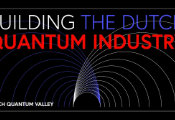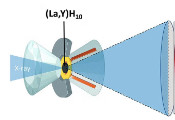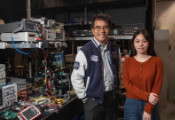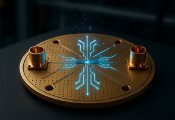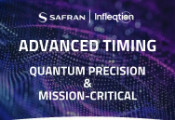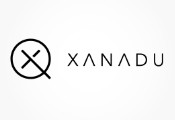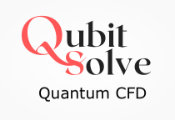Customizable Quantum Control Toolkit Developed at Fermilab Ready for Commercial Production
December 04, 2024 -- Scientists hope to harness the powers of quantum computers to solve unprecedented problems. Central to this goal is the ability to communicate between the quantum and classical computing worlds. To do so, they must manipulate the signals that travel both worlds to optimize their ability to read the information stored within the quantum bits inside a quantum computer.
To help meet these needs, engineers at the U.S. Department of Energy’s Fermi National Accelerator Laboratory created the Quantum Instrumentation Control Kit in 2022. QICK is a combination of a radio frequency circuit board, control and readout hardware and open-source software to control it. Today, with more than 350 registered users worldwide, the engineers created a new companion product called “QICK box,” which they are now ready to bring to market.
This lab-in-a-box can help scientists more easily increase signal-to-noise ratio and qubit control by strengthening the amplification and filtering of incoming and outgoing signals. QICK box includes the original QICK system based on a commercial field-programmable gate array board, or FPGA board, and adds a custom front end with all the electronics and cabling.
“Rather than having to buy a vendor board and the dozens of amplifiers, filters and other hardware needed to connect the equipment, scientists can use the QICK box, which has everything built in, is easy to use and optimized,” said Fermilab engineering physicist Sho Uemura, lead QICK software developer and a core member of the QICK development team.
Not only is the QICK box compact and cost effective, it is also flexible. Scientists can tailor the system to their needs, a bit like building a LEGO® system. They can mix and match their radio and lower frequency circuit boards, and their inputs and outputs. They can choose the number and type of additional daughter boards to buy and add them to the main board.
On the path toward an ideal readout and control system
At the heart of the QICK box is the original QICK, comprised of the FPGA, the control and readout hardware and the open-source software. QICK has ultralow noise and low latency and provides a scalable high density of output and input channels. The new custom hardware preserves these features, but also optimizes space and improves accuracy and precision. Recently, the development team rolled out QICK version 2.0 with new software and firmware, adding functionality including a brand-new core processor to improve quantum control.
Though a few companies are creating similar quantum control systems, QICK is different. The QICK team worked closely with the scientific and quantum information science (QIS) research communities to solve specific and challenging problems at their labs. The hardware used is common to many applications, but there is great flexibility in how researchers use it.
“QICK is very powerful because the field of quantum right now is changing so rapidly,” said Travis Humble, director of Oak Ridge National Laboratory’s Quantum Science Center, one of five national QIS research centers, and a primary driver of QICK’s early and ongoing development.
“I think QICK is entering that research space where we expect there to be a lot of fluctuation in the hardware design, whereas the other companies are not making the radical changes to development we know the QICK box is capable of. It’s really a different model,” said Humble.
The Fermilab team began developing QICK software and firmware in 2020 in collaboration with University of Chicago researchers. The latter aimed to create and test a controller based on a commercial FPGA board, which is often used in scientific experiments and in quantum computing experiments.
While cutting their teeth on designing an adaptable system over the past few years, the Fermilab team developed a close group of collaborators at institutions including Fermilab, the University of Chicago, and Stanford and Princeton Universities. These collaborators provide real-world quantum applications for QICK and present new ideas for potential functionality. They then test and debug the new features before they are added.
For example, Yale University’s Professor Michael Hatridge and his students are using QICK to explore ways to apply quantum techniques they’ve developed to help producers of larger quantum systems more readily use the technology.
“Our goal is to build a model that shows there are better ways to scale up from simple experiments we can do in the lab with a handful of qubits to larger machines. We need it to be big enough in terms of size to prove our techniques work and unique enough in operation to point to some new ways of thinking how to build quantum computers,” said Hatridge.
“We’re using QICK to be a really high-performance, inexpensive platform that we can add to as needed and to push forward control electronics capabilities for more complicated experiments,” Hatridge added.
Thinking outside the box
Fermilab engineer Gustavo Cancelo, who leads the QICK development and commercialization teams, spent most of the last three-plus decades designing electronics for experiments, not individual users. In such cases, he explains, the experiment is the only customer, and it sets the specifications at the very beginning of the design process. With QICK, it’s different.
“We are trying to commercialize a product for users that develop new ideas every day. When you design a car or a TV, you want most people to use it and like it,” said Cancelo. “So, with QICK, we try hard to think ahead and put in functionality we think users will need in the future. Quantum devices are a moving target. Every new user will bring new ideas for qubits that don’t exist yet.”
In just four years, QICK has evolved from a system used by a few scientists for one specific purpose to one used by hundreds worldwide for a variety of applications. With the addition of the customizable QICK box, the engineering team and its supporters and collaborators believe that it will enable future discoveries in science and quantum information science research.

